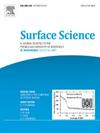Pyridyl-functionalized tripod molecules on Au(111): Interplay between H-bonding and metal coordination
IF 1.8
4区 化学
Q3 CHEMISTRY, PHYSICAL
引用次数: 0
Abstract
The self-assembly of pyridyl-functionalized triazine (T4PT) was studied on Au(111) using low-temperature scanning tunneling microscopy (STM) under ultra-high vacuum conditions combined with density functional theory (DFT) calculations. In particular, we investigated the effect of temperature on the intermolecular interactions within the assemblies. STM measurements revealed that T4PT molecules formed a well-ordered, close-packed structure, with the molecules adopting a planar conformation parallel to the Au surface for coverages monolayer upon room temperature deposition. The intermolecular interactions stabilizing the self-assembled arrangement are based on a combination of hydrogen bonding and weak van der Waals forces. Upon post-deposition annealing up to C, the assemblies were additionally stabilized by metal–ligand bonding between the pyridyl ligands and native Au adatoms. Further post-deposition annealing at temperatures above C led to the breaking of the N-Au bonds with the molecular assemblies transforming into a second close-packed hydrogen-bonded structure. For temperatures exceeding C, few covalently linked dimers formed, most likely as a result of CH-bond activation. We rationalize the kinetically-driven structure formation by unveiling the interaction strengths of the different bonding motifs using DFT and compare the respective molecular conformations to the ones of the structurally similar pyridyl-functionalized benzene (T4PB).

Au(111)上吡啶功能化的三脚架分子:氢键与金属配位之间的相互作用
利用低温扫描隧道显微镜(STM)结合密度泛函理论(DFT)计算,研究了吡啶基功能化三嗪(T4PT)在Au(111)上的自组装行为。特别地,我们研究了温度对组装内部分子间相互作用的影响。STM测量表明,室温沉积时,T4PT分子形成了有序、紧密排列的结构,分子呈平行于Au表面的平面构象,覆盖面积≤1层。稳定自组装排列的分子间相互作用是基于氢键和弱范德华力的结合。沉积后退火至200°C时,吡啶基配体和天然Au配原子之间的金属配体键进一步稳定了组装体。在200°C以上的温度下进一步的沉积后退火导致N-Au键断裂,分子组合转变为第二个紧密排列的氢键结构。当温度超过230°C时,很少形成共价二聚体,这很可能是ch键活化的结果。我们利用离散傅里叶变换揭示了不同键基的相互作用强度,从而理顺了动力学驱动的结构形成,并将各自的分子构象与结构相似的吡啶基功能化苯(T4PB)的分子构象进行了比较。
本文章由计算机程序翻译,如有差异,请以英文原文为准。
求助全文
约1分钟内获得全文
求助全文
来源期刊

Surface Science
化学-物理:凝聚态物理
CiteScore
3.30
自引率
5.30%
发文量
137
审稿时长
25 days
期刊介绍:
Surface Science is devoted to elucidating the fundamental aspects of chemistry and physics occurring at a wide range of surfaces and interfaces and to disseminating this knowledge fast. The journal welcomes a broad spectrum of topics, including but not limited to:
• model systems (e.g. in Ultra High Vacuum) under well-controlled reactive conditions
• nanoscale science and engineering, including manipulation of matter at the atomic/molecular scale and assembly phenomena
• reactivity of surfaces as related to various applied areas including heterogeneous catalysis, chemistry at electrified interfaces, and semiconductors functionalization
• phenomena at interfaces relevant to energy storage and conversion, and fuels production and utilization
• surface reactivity for environmental protection and pollution remediation
• interactions at surfaces of soft matter, including polymers and biomaterials.
Both experimental and theoretical work, including modeling, is within the scope of the journal. Work published in Surface Science reaches a wide readership, from chemistry and physics to biology and materials science and engineering, providing an excellent forum for cross-fertilization of ideas and broad dissemination of scientific discoveries.
 求助内容:
求助内容: 应助结果提醒方式:
应助结果提醒方式:


